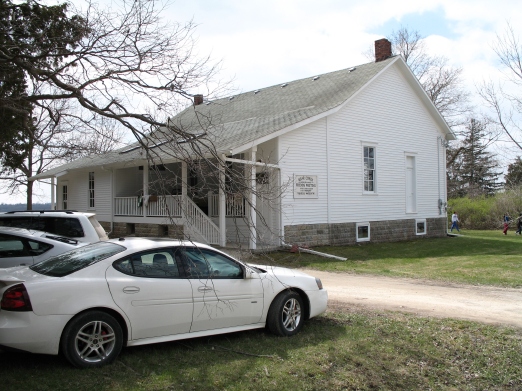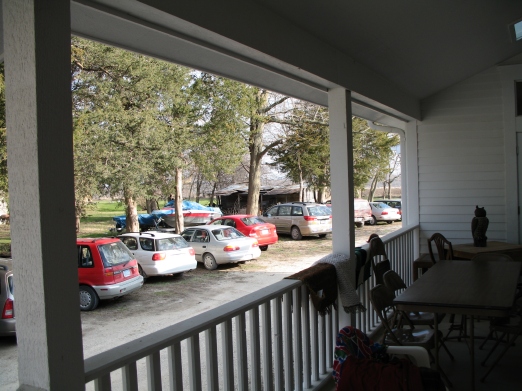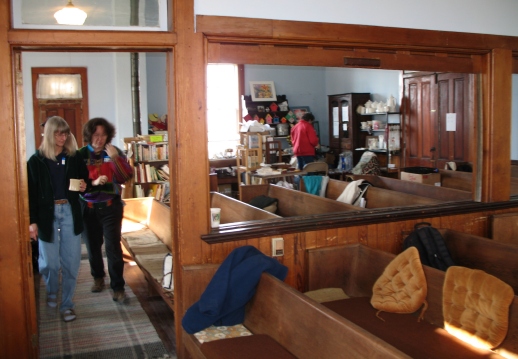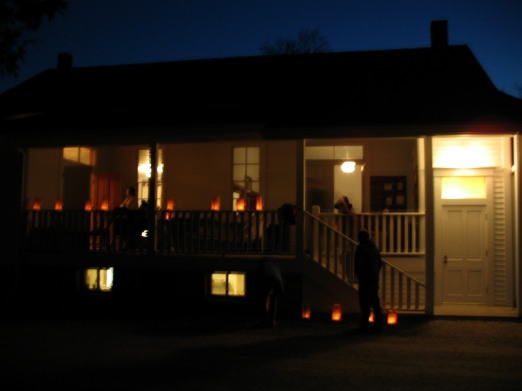Images from Iowa (Conservative)
 For those of you who are curious what Iowa Conservative Quakerism looks like, I’ve taken a few pictures of the Bear Creek Meetinghouse, where our Midyear Meeting is in session.
For those of you who are curious what Iowa Conservative Quakerism looks like, I’ve taken a few pictures of the Bear Creek Meetinghouse, where our Midyear Meeting is in session.
 This first is a photo of the meetinghouse. You can’t tell from the photo, but it’s situated way out among the cornfields, on a ridge about fifteen minutes’ drive west of the Des Moines suburbs. The oldest part of the structure was built in 1902. Something like ninety people were in it today — a fairly good turnout for a midyear meeting.
This first is a photo of the meetinghouse. You can’t tell from the photo, but it’s situated way out among the cornfields, on a ridge about fifteen minutes’ drive west of the Des Moines suburbs. The oldest part of the structure was built in 1902. Something like ninety people were in it today — a fairly good turnout for a midyear meeting.
 Here’s a view from the porch, where Friends hang out on mild days. Alas, today was too cold for much hanging out. The trees you see serve as a windbreak, a necessary thing given the severity of Iowa winds and winter storms.
Here’s a view from the porch, where Friends hang out on mild days. Alas, today was too cold for much hanging out. The trees you see serve as a windbreak, a necessary thing given the severity of Iowa winds and winter storms.
 Here we are looking from the front of the old men’s meeting room, through the open door and window of the partition, into the old women’s meeting room. At the top of the window in the partition you can see the lower edge of the heavy wooden blind that was lowered to separate the two meetings. In the women’s meeting room, that long black vertical pipe visible through the doorway is connected to the old iron stove Friends used to heat the place in winter. (The practice of segregating the sexes in separate men’s and women’s meetings was discontinued here in 1935.) Those (deliberately) uncomfortable wooden benches were built from huge walnut trees that were standing in the bottomlands when Friends first settled here; the planks in the benches are up to sixteen feet long and quite free of knots. You can’t find walnut wood of that quality any more!
Here we are looking from the front of the old men’s meeting room, through the open door and window of the partition, into the old women’s meeting room. At the top of the window in the partition you can see the lower edge of the heavy wooden blind that was lowered to separate the two meetings. In the women’s meeting room, that long black vertical pipe visible through the doorway is connected to the old iron stove Friends used to heat the place in winter. (The practice of segregating the sexes in separate men’s and women’s meetings was discontinued here in 1935.) Those (deliberately) uncomfortable wooden benches were built from huge walnut trees that were standing in the bottomlands when Friends first settled here; the planks in the benches are up to sixteen feet long and quite free of knots. You can’t find walnut wood of that quality any more!
 At the conclusion of our discussion this evening, our presenter, Paul Buckley, had us light up the exterior of the meetinghouse with luminaria.
At the conclusion of our discussion this evening, our presenter, Paul Buckley, had us light up the exterior of the meetinghouse with luminaria.
I’ll report on the actual events of our meeting in a future posting. It’s too soon to do so now, since we still have another half day of the meeting to go!





Reader Comments (2)
At Hoover's Birthplace in West Branch near Iowa City, one finds, not only the spacious beginnings of restored native prairie, but also the old Meeting House that Hoover's family went to, preserved near the homestead cabin he was born in. A beautiful piece of carpentry, like the one pictured above. If only Hoover had had the openness or imagination to discern that all the strategies that had worked so well for him before, whether making money or feeding Belgium, were not working after 1929. Not that I would want to exchange FDR for Hoover, but that one knows a great deal of needless suffering, and a sad period of depression for Hoover himself, ensued. (Which didn't stop him from retiring to the Waldorf Astoria.)
Actually, our yearly meeting gathers every summer at Hickory Grove Meeting, on the grounds of Scattergood School, just a few miles east of West Branch. That's yet another of the old nineteenth-century meetinghouses. Richard Nixon's grandmother is buried there.
Hoover, though, belonged to the Five Years Meeting branch of Friends, not to our Conservative branch. The Five Years Meeting branch had gotten caught up in the Holiness Revival movement during the late nineteenth century, and was, by Hoover's day, a world of hymn singing, altar calls, and come-to-Jesus sermons. Despite the old-fashioned look of Hoover's meetinghouse, it was a world closer to what people nowadays call evangelical Protestantism than to traditional Quakerism.